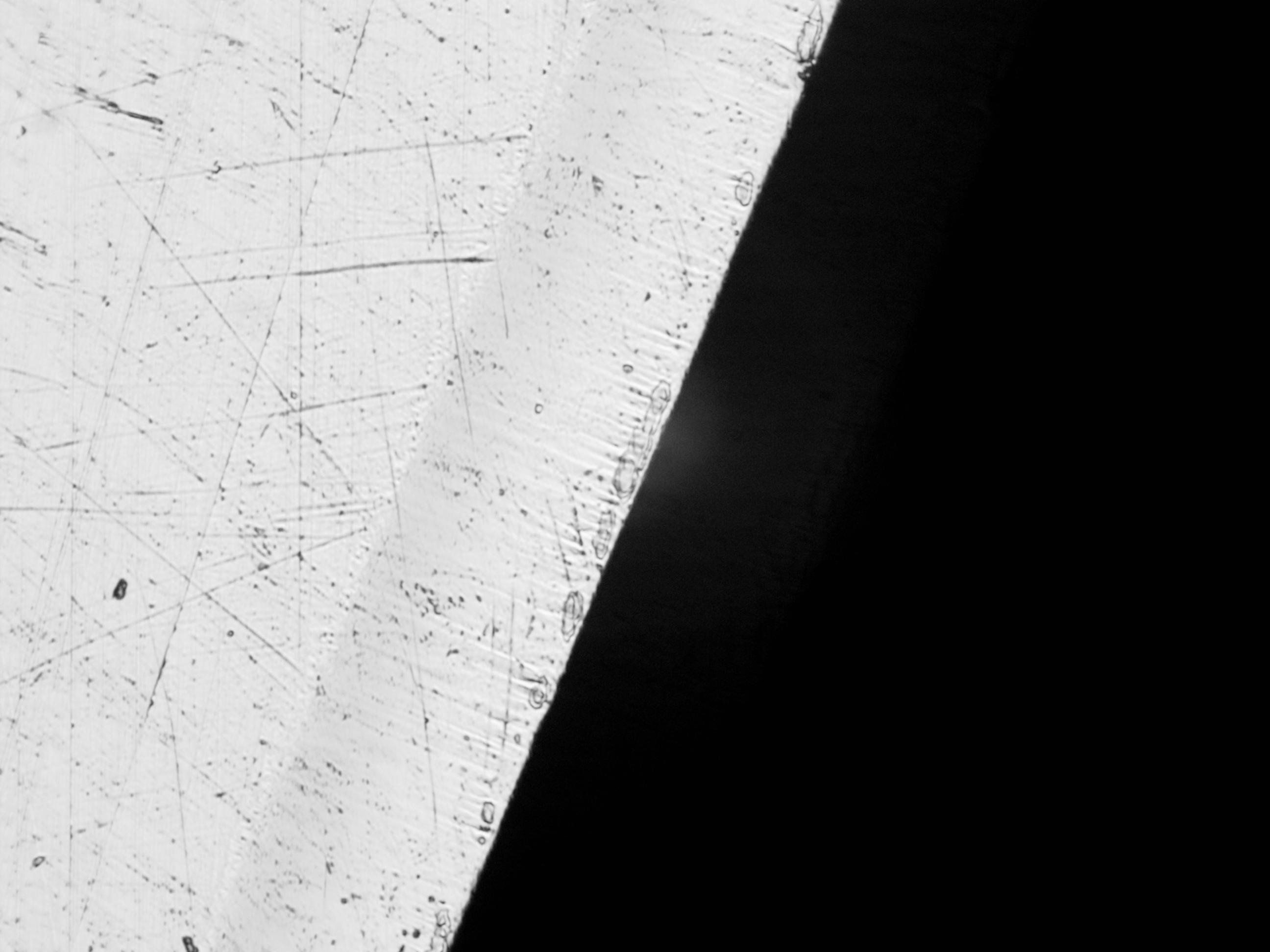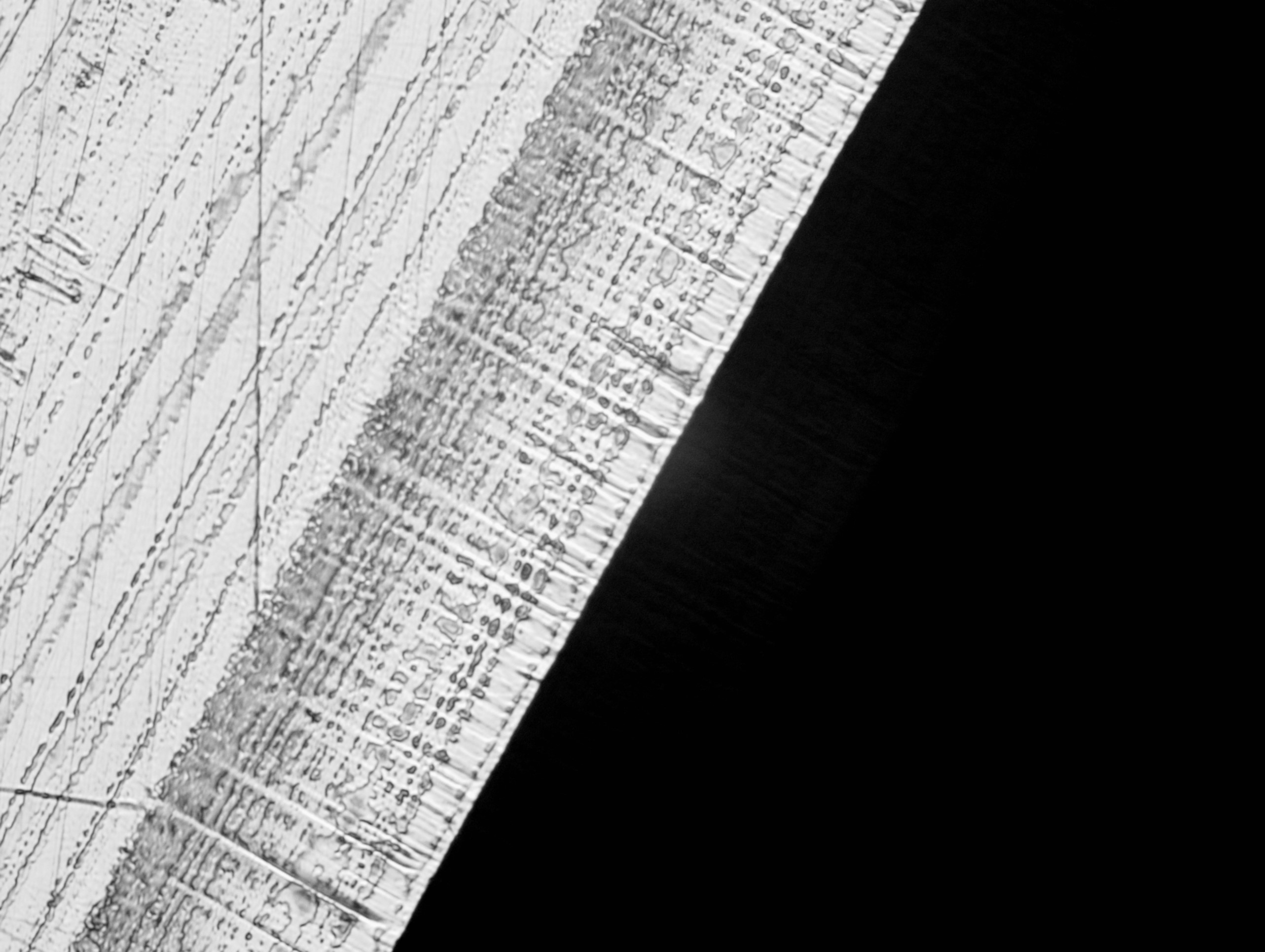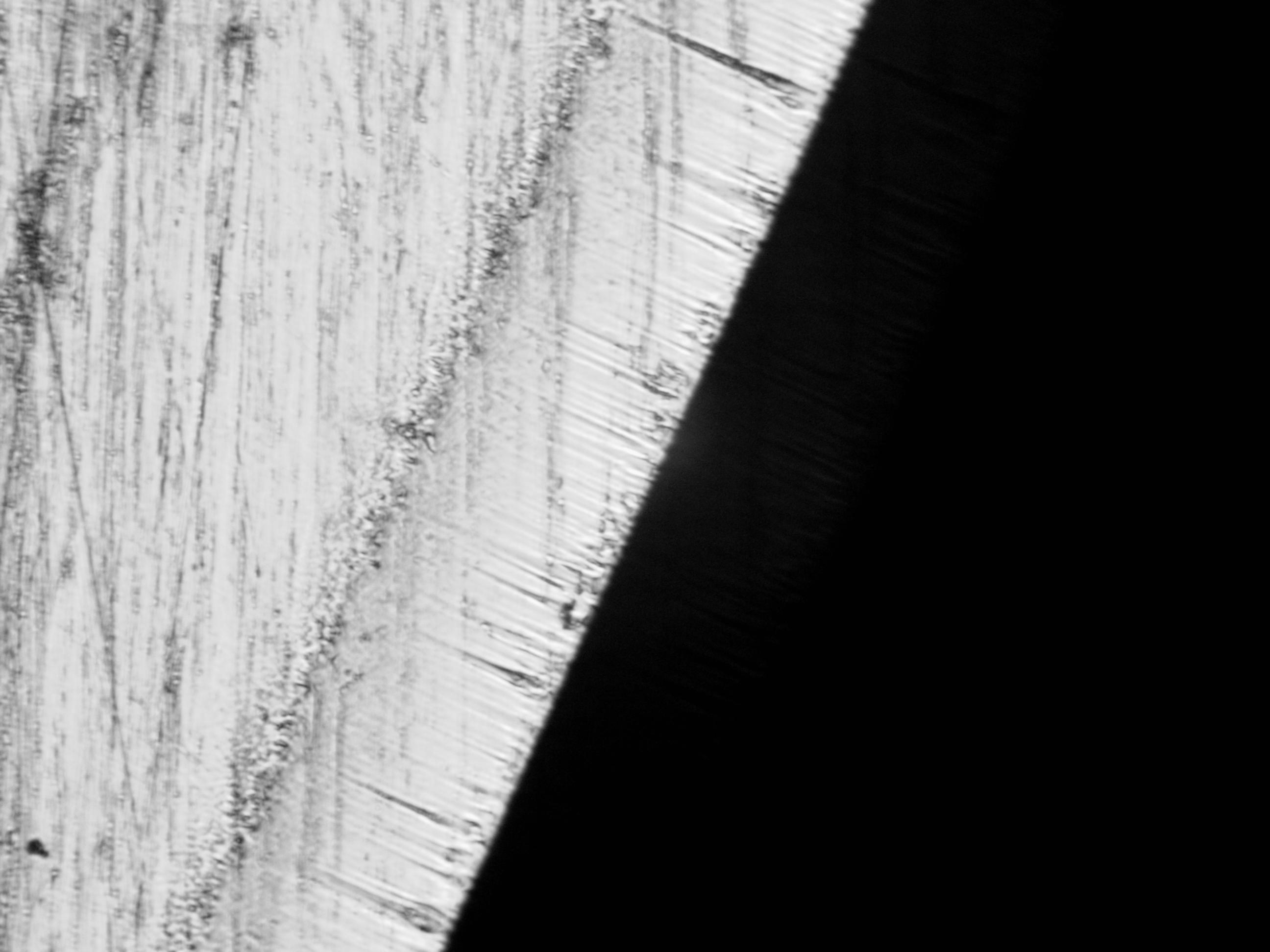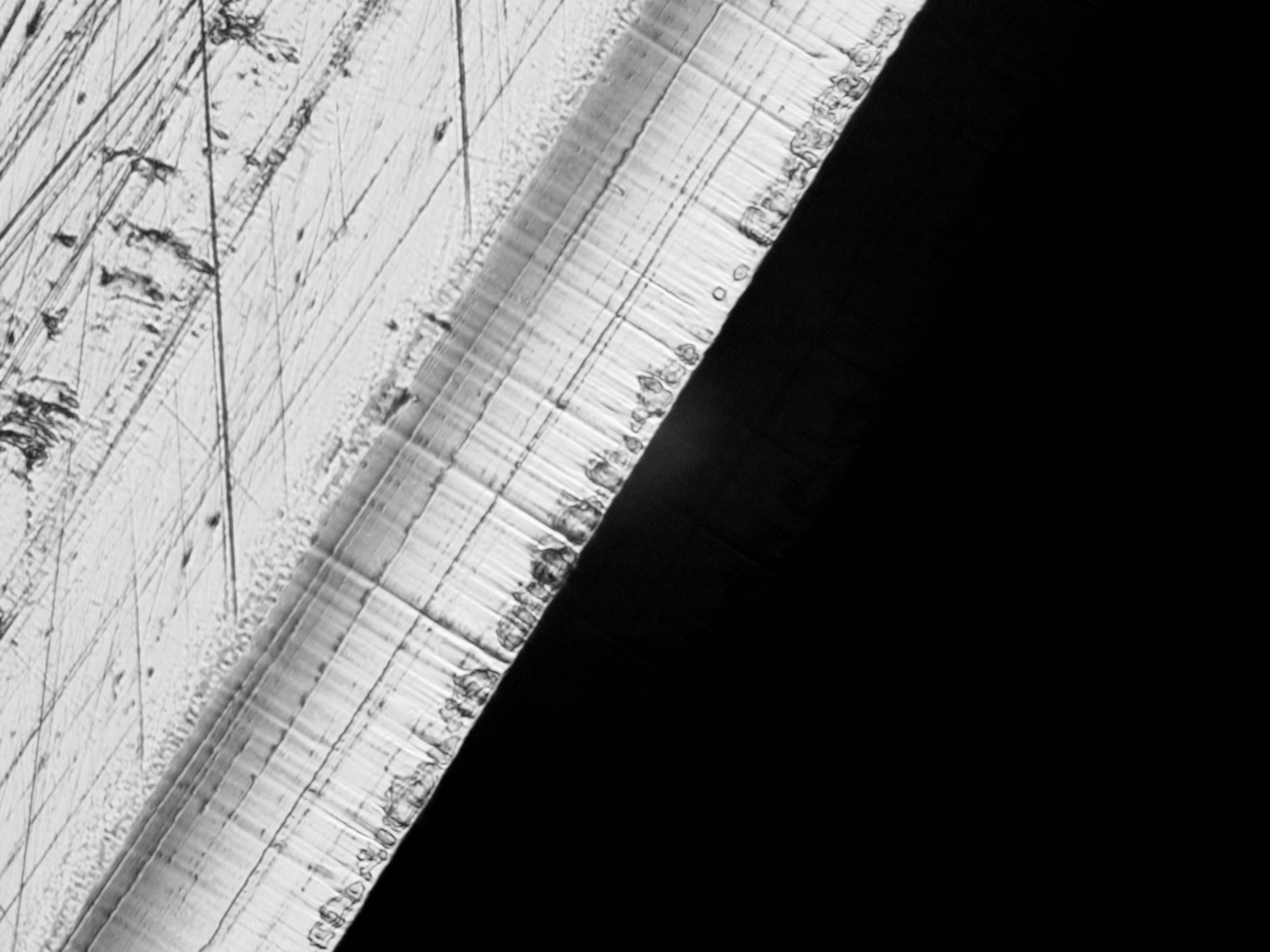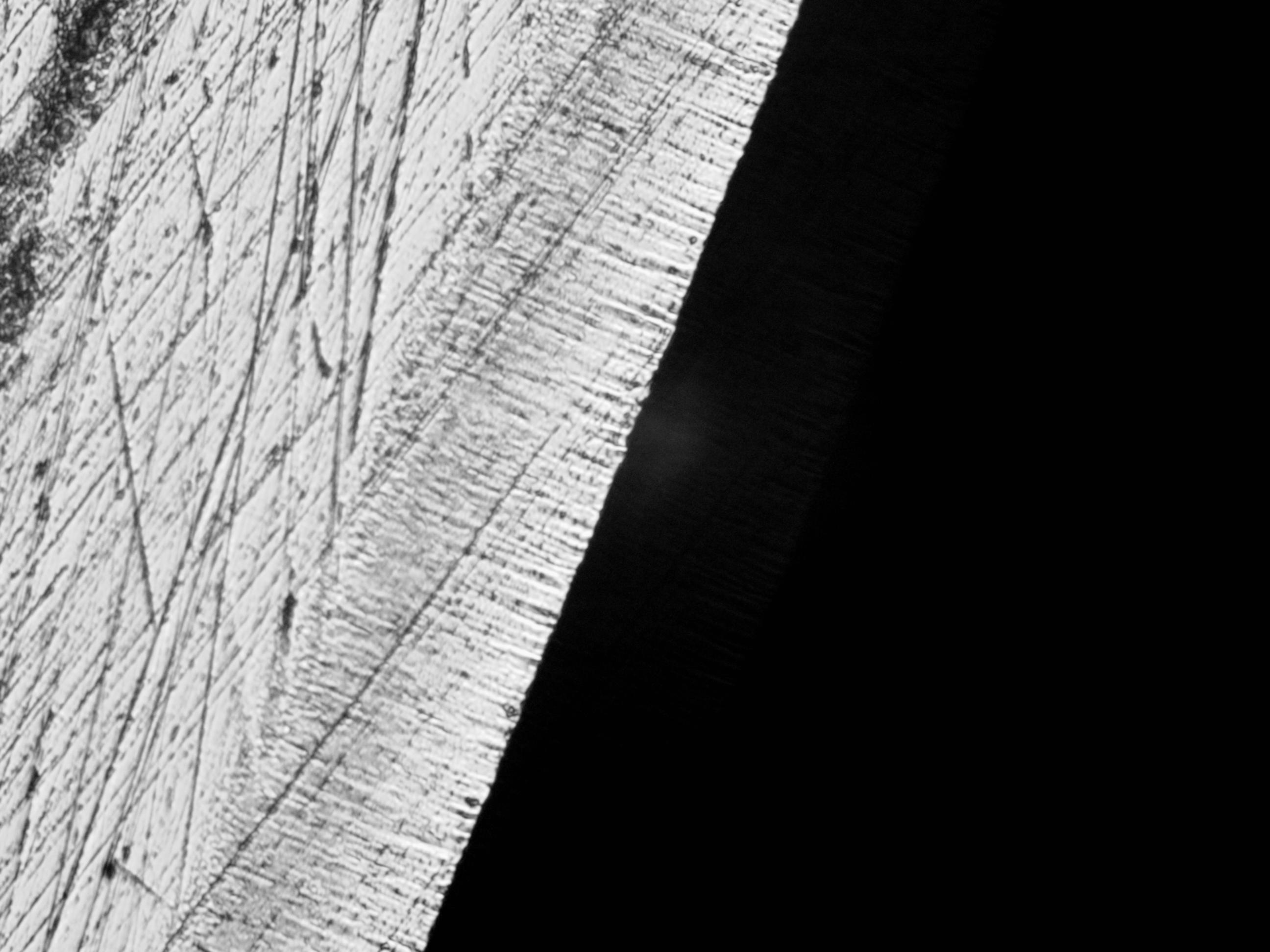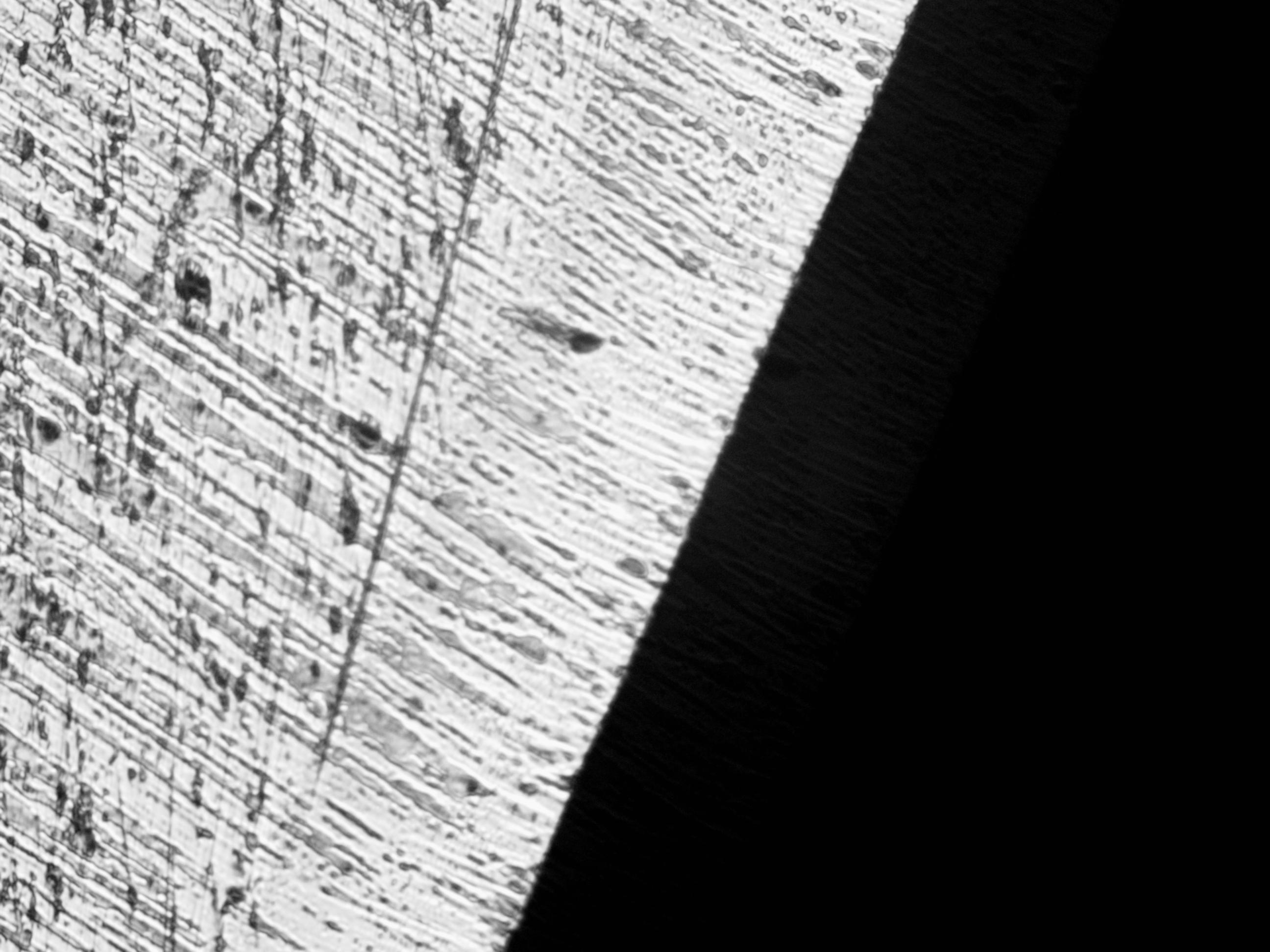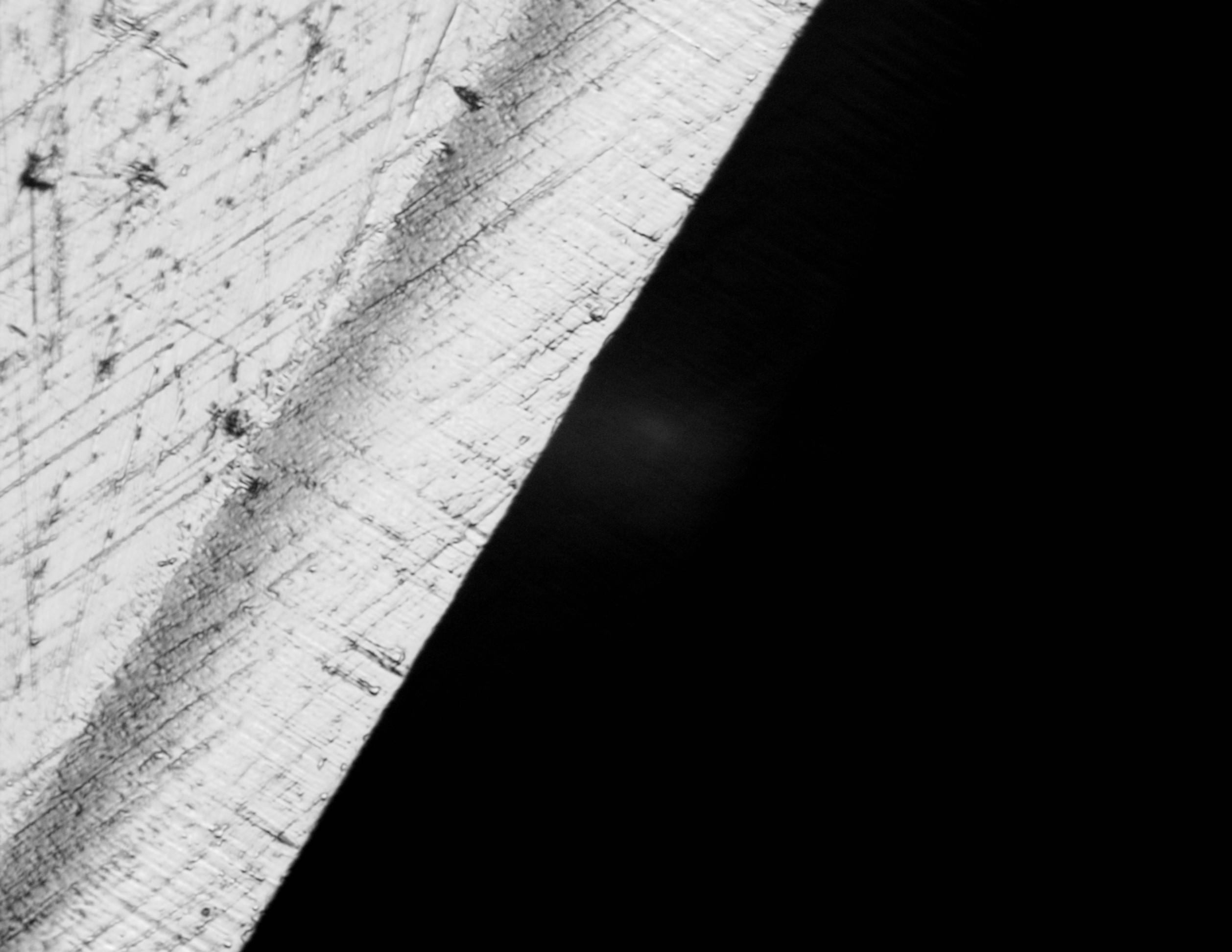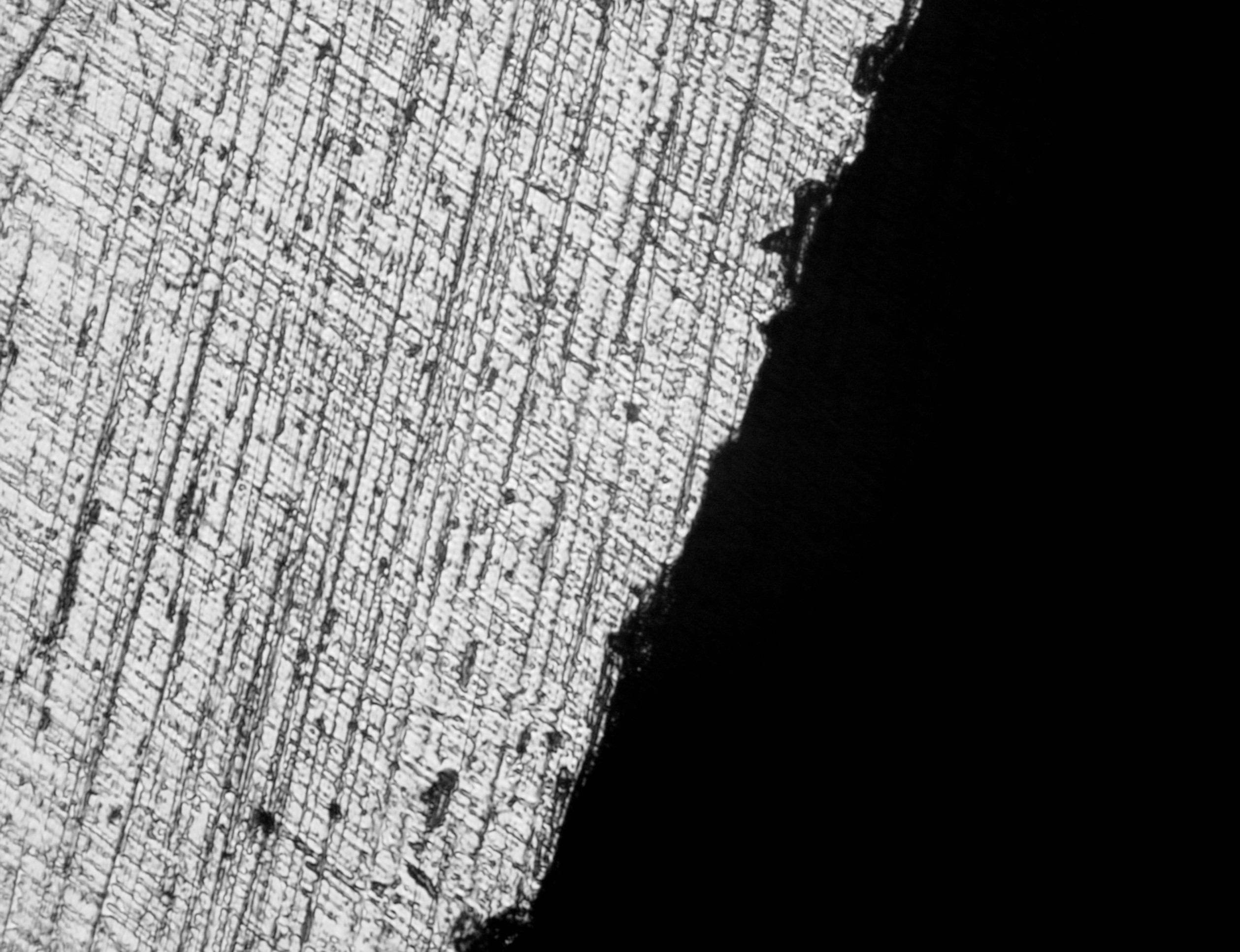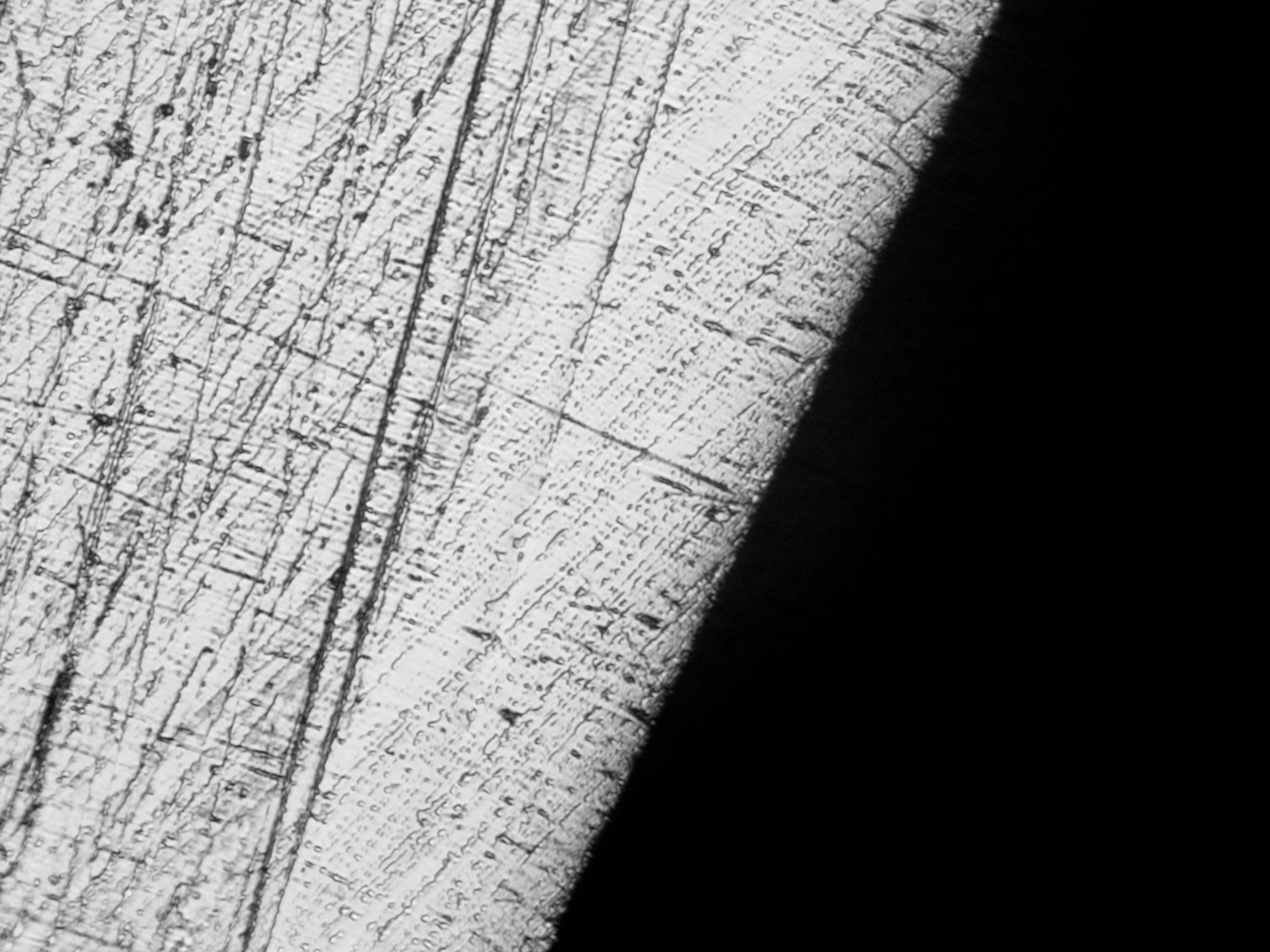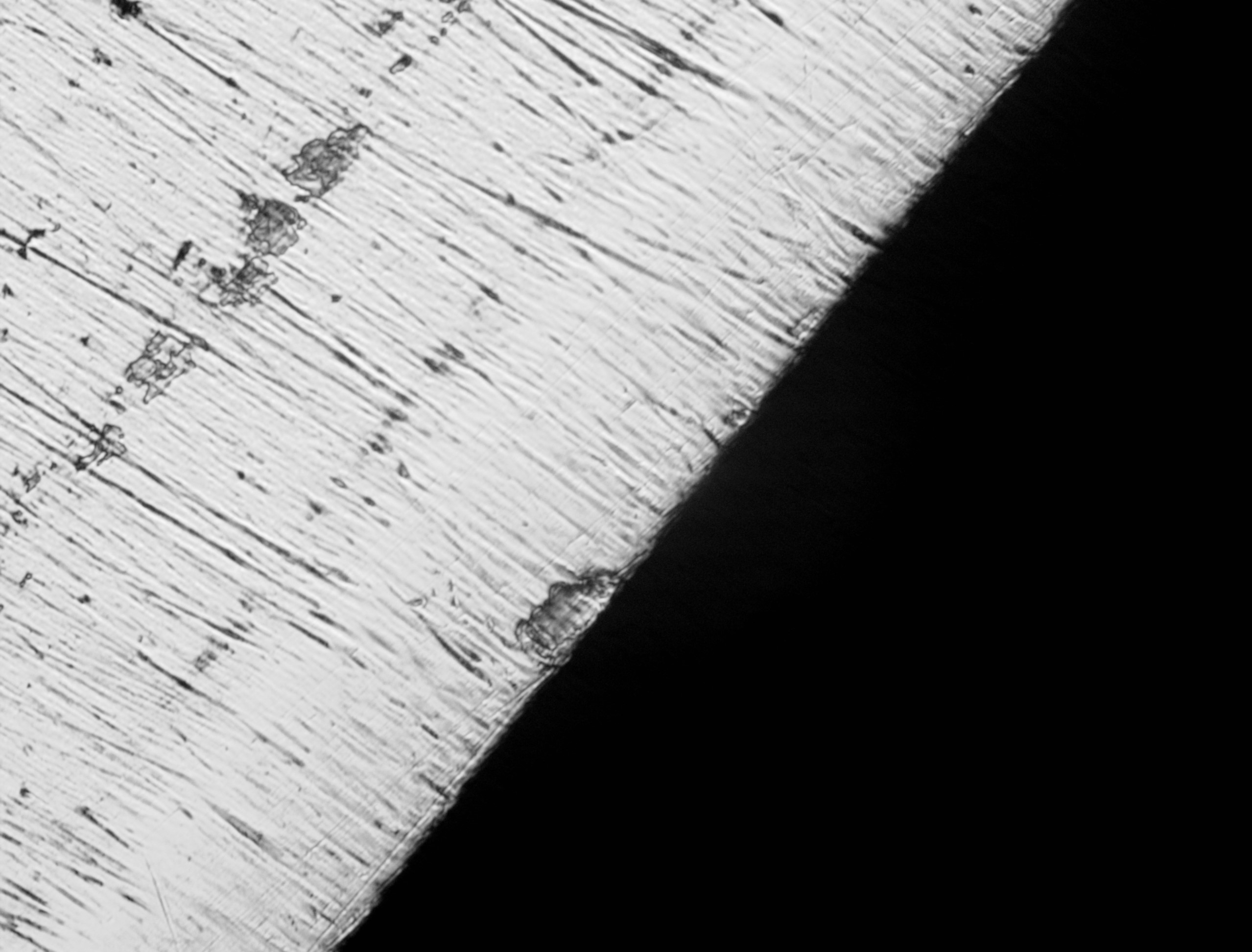Last year, I tested a bunch of plane irons. A few simple irons and then everything from A2 to CPM M4. M4 ended up lasting the longest, and V11 was just on its heels. I've found since that if you're planing rough wood, V11 and the alloy that it's made of (or suspected, I don't know for sure) is high hardness for stainless but not high toughness. It's abrasion resistant when honing and grinds slowly, so it's fairly easy on something like a jointer to end up never having all of the damage out of an iron unless you spend proportional time sharpening (or more) and using maybe a sharpening media you don't want to.
So I've gone back to O1 and the likes (or simpler) for all pre-smoothing work, and to be truthful, I've not used the V11 alloy (my make or LV's) for much of this year as I've made three projects out of "trash wood" that has knots and such. It's easier to use a soft iron that has good toughness and can be refreshed fast on one stone and the buffer.
That leads me back to testing somethings that I'd gotten before V11 and a couple after:
- 1084 steel
- 1095 steel
- 52100
- AEB-L (a fine grained stainless that was developed for razor blades and that I threw in at the last second here after being told by a metallurgist that I might like it. It's not a PM like V11, it doesn't have that high of carbon like V11, but it has the finest grain structure of any stainless that I'm aware of - finer than any of the stainless PMs). It also has a reputation with small carbides of being tough and sharpening more like a carbon steel. I'm in
- 01 - the same iron I used in my prior test, which helps me make some connections
1084 and 1095 are two different plain steels used for two different reasons (1084 doesn't develop much for free carbides and thus stays tough. Lack of carbides means it wears a little faster, but it sharpens easily at any given hardness). 1095 us sort of the plainest 1% carbon steel you can find, but I've found out that it's too plain and a couple of the alloying elements that make a slightly less simple steel get full hardness more easily are a good idea. small amounts of elements can also improve toughness. My guess is that the really simple high carbon steels wiht a little bit of additives are what's in files, which have big demands on their teeth and are really high hardness. I just have no idea what's actually used in files and i'm fairly sure that the assumption that it's 1095 is wrong because they don't harden the same.
52100 is a steel regarded as tough at high hardness and favored in the knife world over 01 for several reasons. Its structure (some alloying elements, but still pretty plain) suggests that it should last about like 01.
The test is in plain maple, 200 feet against the grain (which is harder on an edge) and then the rest with the grain.
the results that I got are as follows:
1084 steel - 997 feet
1095 steel - 836 feet (toughness problems, and nicking which shortened edge life but they wore off by the end of the test and the edge looked wonderful - I think a few extra degrees or some buffing of the tip to remove the weak apex would make it a better peformer, but why when 1084 works so well and is easier to get right hardening because the grain structure never really degrades in simple heat treating.
52100 - 1235 feet (lovely, hard crisp edge and nearly no chipping even against the grain with a fresh edge
O1 - 1231 feet (almost indistinguishable vs. the 52100 iron, though the small amount of alloying in each is not the same - the result is similar. O1 is probably a little easier to heat treat as it's designed to harden deeper in large items)
AEB-L - two tests averaged 2000 feet. This is a surprise. AEB-L (also sold by sandvik as 13c26) has less than 0.7% carbon and has about 13% chromium and a few other additives. It works out that the combination leaves no large free carbides. I expected the low carbon to make the edge tricky and once I figured out how to harden and temper it in open atmosphere (it can do better when commercially done, but would need specific temperature cycling and cryo treatment). It just keeps cutting, almost as long as V11, but the steel cost for AEB-L is about a fifth of the cost of V11's base stock and it's available in more sizes. It also sharpens easily on india stones and oilstones and has great toughness.
In order to harden and temper it, though, one needs to be able to get close to 2000 degrees but not go beyond (higher than that and it will lose hardness rather than gain it unless you can dip it in liquid nitrogen (if you can do that, it can get up to 65/66 initial hardness, which gives you a lot of room to temper it back). The high temperature is needed as it's not PM and chromium will not dissolve into the solution at lower temperatures. The rest of the steel will harden, but the chromium will just chip right off of the edge. BTDT on the first try.
I can tolerate heating it (by color) in the temperature range for about 3 minutes before I can't stand sitting and looking at it longer, and don't want to have more carbon float off into the atmosphere than needed. That seems to be enough, and my sample which I thought was soft at first (due to the decarb layer) is now in the toaster oven tempering back a little bit as after a few sharpenings, i'd like it to be a bit easier/freer grinding, but at this point, it is wearing smooth and even like a carbon steel (albeit a hard one) and lasting a very long time (unlike A2, which grinds much more slowly than carbon steel but offers longevity only slightly longer and a trash edge during that longer period).
I had a couple of failed tests, and this was overall a mini-test (only about 9000 feet of total planing vs. closer to 40-50k in the original test.
What are the chances that AEB-L will ever make it into a commercial plane iron? Pretty low, I think. It's probably been around 50 years already and you can't just dip it in oil to quench and then dip it in salt or high temp oil to temper like you can with O1. And so far, it's a bit less stable (warps a little bit) in quench vs. A2 which has great dimensional stability.
In short, it's better for us than A2, but A2 is probably easier for makers to work with (and their contracted heat treat for the makers who send stuff off).
I do think also that AEB-L has the potential (unlike V11 for me) to do the whole range of work and have nicking removed just in the process of regular honing and grinding, which means no working late in a project finish planing a surface only to see a shaving still splitting right after a brisk sharpening session.
Too on top of that, for someone who likes really easy to sharpen and good toughness, 1084 performed very respectably. It sharpens like butter, even at relatively high hardness, because there's nothing in it to resist the stones.
So I've gone back to O1 and the likes (or simpler) for all pre-smoothing work, and to be truthful, I've not used the V11 alloy (my make or LV's) for much of this year as I've made three projects out of "trash wood" that has knots and such. It's easier to use a soft iron that has good toughness and can be refreshed fast on one stone and the buffer.
That leads me back to testing somethings that I'd gotten before V11 and a couple after:
- 1084 steel
- 1095 steel
- 52100
- AEB-L (a fine grained stainless that was developed for razor blades and that I threw in at the last second here after being told by a metallurgist that I might like it. It's not a PM like V11, it doesn't have that high of carbon like V11, but it has the finest grain structure of any stainless that I'm aware of - finer than any of the stainless PMs). It also has a reputation with small carbides of being tough and sharpening more like a carbon steel. I'm in
- 01 - the same iron I used in my prior test, which helps me make some connections
1084 and 1095 are two different plain steels used for two different reasons (1084 doesn't develop much for free carbides and thus stays tough. Lack of carbides means it wears a little faster, but it sharpens easily at any given hardness). 1095 us sort of the plainest 1% carbon steel you can find, but I've found out that it's too plain and a couple of the alloying elements that make a slightly less simple steel get full hardness more easily are a good idea. small amounts of elements can also improve toughness. My guess is that the really simple high carbon steels wiht a little bit of additives are what's in files, which have big demands on their teeth and are really high hardness. I just have no idea what's actually used in files and i'm fairly sure that the assumption that it's 1095 is wrong because they don't harden the same.
52100 is a steel regarded as tough at high hardness and favored in the knife world over 01 for several reasons. Its structure (some alloying elements, but still pretty plain) suggests that it should last about like 01.
The test is in plain maple, 200 feet against the grain (which is harder on an edge) and then the rest with the grain.
the results that I got are as follows:
1084 steel - 997 feet
1095 steel - 836 feet (toughness problems, and nicking which shortened edge life but they wore off by the end of the test and the edge looked wonderful - I think a few extra degrees or some buffing of the tip to remove the weak apex would make it a better peformer, but why when 1084 works so well and is easier to get right hardening because the grain structure never really degrades in simple heat treating.
52100 - 1235 feet (lovely, hard crisp edge and nearly no chipping even against the grain with a fresh edge
O1 - 1231 feet (almost indistinguishable vs. the 52100 iron, though the small amount of alloying in each is not the same - the result is similar. O1 is probably a little easier to heat treat as it's designed to harden deeper in large items)
AEB-L - two tests averaged 2000 feet. This is a surprise. AEB-L (also sold by sandvik as 13c26) has less than 0.7% carbon and has about 13% chromium and a few other additives. It works out that the combination leaves no large free carbides. I expected the low carbon to make the edge tricky and once I figured out how to harden and temper it in open atmosphere (it can do better when commercially done, but would need specific temperature cycling and cryo treatment). It just keeps cutting, almost as long as V11, but the steel cost for AEB-L is about a fifth of the cost of V11's base stock and it's available in more sizes. It also sharpens easily on india stones and oilstones and has great toughness.
In order to harden and temper it, though, one needs to be able to get close to 2000 degrees but not go beyond (higher than that and it will lose hardness rather than gain it unless you can dip it in liquid nitrogen (if you can do that, it can get up to 65/66 initial hardness, which gives you a lot of room to temper it back). The high temperature is needed as it's not PM and chromium will not dissolve into the solution at lower temperatures. The rest of the steel will harden, but the chromium will just chip right off of the edge. BTDT on the first try.
I can tolerate heating it (by color) in the temperature range for about 3 minutes before I can't stand sitting and looking at it longer, and don't want to have more carbon float off into the atmosphere than needed. That seems to be enough, and my sample which I thought was soft at first (due to the decarb layer) is now in the toaster oven tempering back a little bit as after a few sharpenings, i'd like it to be a bit easier/freer grinding, but at this point, it is wearing smooth and even like a carbon steel (albeit a hard one) and lasting a very long time (unlike A2, which grinds much more slowly than carbon steel but offers longevity only slightly longer and a trash edge during that longer period).
I had a couple of failed tests, and this was overall a mini-test (only about 9000 feet of total planing vs. closer to 40-50k in the original test.
What are the chances that AEB-L will ever make it into a commercial plane iron? Pretty low, I think. It's probably been around 50 years already and you can't just dip it in oil to quench and then dip it in salt or high temp oil to temper like you can with O1. And so far, it's a bit less stable (warps a little bit) in quench vs. A2 which has great dimensional stability.
In short, it's better for us than A2, but A2 is probably easier for makers to work with (and their contracted heat treat for the makers who send stuff off).
I do think also that AEB-L has the potential (unlike V11 for me) to do the whole range of work and have nicking removed just in the process of regular honing and grinding, which means no working late in a project finish planing a surface only to see a shaving still splitting right after a brisk sharpening session.
Too on top of that, for someone who likes really easy to sharpen and good toughness, 1084 performed very respectably. It sharpens like butter, even at relatively high hardness, because there's nothing in it to resist the stones.





